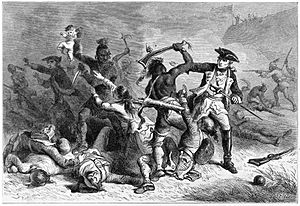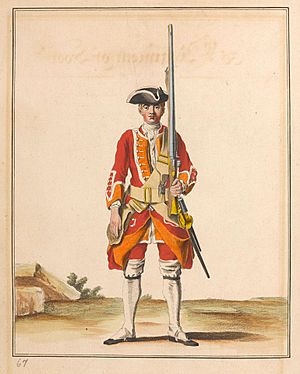35th (Royal Sussex) Regiment of Foot facts for kids
Quick facts for kids 35th (Royal Sussex)Regiment of Foot |
|
|---|---|
| Active | 1701–1881 |
| Country |
|
| Branch | |
| Type | Infantry |
| Garrison/HQ | Roussillon Barracks, Chichester |
| Nickname(s) | "The Orange Lillies" "The Prince of Orange's Own Regiment" |
| Motto(s) | Honi soit qui mal y pense |
| Colours | Orange Facings |
| Anniversaries | Quebec Day |
| Engagements | French and Indian War American War of Independence Napoleonic Wars Indian Rebellion |
| Commanders | |
| Notable commanders |
Arthur Chichester, 3rd Earl of Donegall Charles Lennox, 4th Duke of Richmond |
The 35th (Royal Sussex) Regiment of Foot was a special group of soldiers in the British Army. They were like a team of foot soldiers, also known as infantry. This regiment was first formed in 1701. Later, in 1881, it joined with another regiment, the 107th (Bengal Infantry) Regiment of Foot, to create the Royal Sussex Regiment. This change was part of big army updates called the Childers Reforms.
Contents
History of the 35th Regiment
How the Regiment Started
The 35th Regiment began in Belfast, a city in Ireland. It was started on June 28, 1701, by a leader named Arthur Chichester, 3rd Earl of Donegall. At first, it was called the Earl of Donegall's Regiment of Foot. It was also known as the Belfast Regiment.
This new group of soldiers was formed to fight in a big war called the War of the Spanish Succession. The regiment was very strong in its Protestant beliefs. They were given special permission by King William III to wear orange colors on their uniforms. This showed their loyalty and was a special royal gift.
Early Adventures and Challenges
In 1702, Queen Anne ordered the regiment to serve with the Royal Navy. This meant they would fight at sea. They took part in the Battle of Cádiz in August 1702. They also helped defend Gibraltar in 1705.
During the siege of Barcelona in 1706, their leader, the Earl of Donegall, was killed. After his death, Brigadier Richard Gorges became the new colonel. The regiment was then called Gorges's Regiment of Foot.
In April 1707, the regiment faced a terrible defeat at the Battle of Almansa. Most of their soldiers were lost, and they even lost their special flags, called regimental colors. The few survivors went back to Ireland to rebuild their strength. In 1751, a new rule said that regiments should be known by their number, not their colonel's name. So, Gorges's regiment became the 35th Regiment of Foot.
Fighting in the Seven Years' War

In 1756, the regiment sailed to America to fight in the Seven Years' War. In August 1757, their leader, Lieutenant-Colonel George Monro, defended Fort William Henry. But they had to give up to a much larger French army. The French commander, the Marquis de Montcalm, allowed the British soldiers to leave with their weapons.
However, some Native American allies of the French attacked the retreating British soldiers. The regiment later got their chance for revenge on Montcalm. In September 1759, they fought under General James Wolfe at the Battle of the Plains of Abraham. It was said that the 35th Regiment defeated a French regiment that had been at Fort William Henry. As a trophy, they took white feathers from the French soldiers' hats. This 'Roussillon Plume' later became part of their badge.
The regiment also fought in the Battle of Sainte-Foy and the siege of Quebec in 1760. They helped capture Montreal in September 1760. After that, they took part in the invasion of Martinique and the capture of Havana in Cuba in 1762. They returned to England in 1765.
American Revolution Battles
The regiment went back to America in April 1775 to fight in the American Revolutionary War. They suffered many losses at the Battle of Bunker Hill in June 1775. Many officers and soldiers were killed or hurt.
They also faced tough times during the siege of Boston in 1776. Then they sailed to New York. They fought in the Battle of Long Island and the Battle of Harlem Heights. Their commander, Lieutenant Colonel Robert Carr, was killed at the Battle of White Plains in October 1776. The regiment continued to fight in the Philadelphia campaign in 1777. In 1778, they went to the West Indies and helped capture St. Lucia. They finally returned to England in 1785.
New Names for the Regiment
In 1782, King George III added county names to regiments to help them find new soldiers. The regiment became the 35th (Dorsetshire) Regiment.
The first real link to Sussex came in 1787. That's when Charles Lennox, 4th Duke of Richmond, joined the regiment. He helped recruit soldiers from Sussex. In 1805, he got royal permission for the regiment to be called "Sussex." So, it became the 35th (Sussex) Regiment of Foot.
Napoleonic Wars and Beyond
In 1794, the regiment was part of a British force that captured several forts in Martinique. They also captured Saint Lucia. They tried to take Guadeloupe but were not successful.
The regiment also fought in the Anglo-Russian invasion of Holland in 1799. They took part in battles like the Battle of Bergen and the Battle of Alkmaar. They later helped take back Malta from the French in 1800.
A second group of soldiers, called a 2nd battalion, was formed in 1804. The 1st battalion fought in the Battle of Maida in Italy in 1806 during the Napoleonic Wars. They played a very important part in this battle.
However, they lost many soldiers defending Alexandria in 1807. They had to move to Sicily. The 2nd battalion was part of the difficult Walcheren Campaign in 1809. Their commander, Lieutenant Colonel Peter Petit, died from his injuries during the siege of Flushing.
Meanwhile, the 1st battalion captured islands like Zakynthos and Cephalonia in 1809, and Lefkada in 1810. They also helped capture Genoa in Italy in 1814. In 1813, the 2nd battalion went to the Netherlands. They later fought in the famous Battle of Waterloo in June 1815.
The Victorian Era and End of the Regiment
On June 15, 1832, the regiment was given a special honor. It was allowed to be called "Royal" and became the 35th or Royal Sussex Regiment. Their uniform colors were changed from orange to blue.
In August 1854, the regiment went to India. They fought against rebels near Arrah in 1858 during the Indian Rebellion. They returned to England in 1868.
In the 1870s, the army made more changes called the Cardwell Reforms. The 35th Regiment was linked with the 107th (Bengal Infantry) Regiment of Foot. They shared a training base in Chichester. Finally, on July 1, 1881, the Childers Reforms officially combined them. This created the new Royal Sussex Regiment.
Battle Honours
These are some of the special battles the regiment was honored for:
- Napoleonic Wars: Maida
- Gibraltar 1704–05
- Louisburg
- Quebec 1759
- Martinique 1762
- Havannah
- St. Lucia 1778
Uniform
When the regiment was formed in 1701, their red coats had unusual orange facings. This orange color was chosen because of the Earl of Donegall's connection to King William's House of Orange. The orange details stayed on their uniforms until 1832. Then, they changed to royal blue facings. Officers wore silver shoulder decorations and braiding until 1830, when they switched to gold. The basic design of their uniform was similar to what other British foot soldiers wore during that time.




